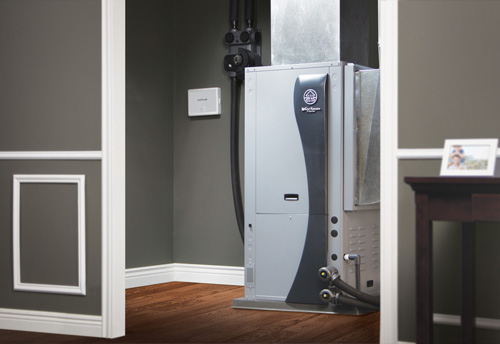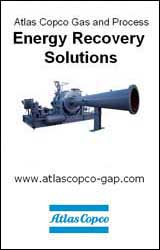Joining Forces to Save Energy: With geothermal heating & cooling
 As geothermal heating and cooling gains in popularity, the relationship between geothermal contractors and electric utilities becomes increasingly important to both parties. From the contractor’s perspective, utilities control electricity, as well as many of the rebate and incentive programs that make the installation of a geothermal system an attractive proposition. Just as importantly, utilities regularly interact with their customers—including potential geothermal customers—and have the ability to influence buying habits, particularly as customers look for new ways to reduce their energy usage.
As geothermal heating and cooling gains in popularity, the relationship between geothermal contractors and electric utilities becomes increasingly important to both parties. From the contractor’s perspective, utilities control electricity, as well as many of the rebate and incentive programs that make the installation of a geothermal system an attractive proposition. Just as importantly, utilities regularly interact with their customers—including potential geothermal customers—and have the ability to influence buying habits, particularly as customers look for new ways to reduce their energy usage.
At the same time, utilities are aware of the service contractors’ provide. After all, contractors install the systems, educating consumers on how geothermal energy works and benefits system owners. This is critical to the success of the incentive programs created by utilities. Moreover, by working with contractors to help sell consumers on geothermal systems, utilities are experiencing reduced electrical demand—by as much as one kilowatt per ton. Reductions like this can help utilities avoid investing millions of dollars in additional capacity.
It should come as little surprise, therefore, that contractors and utilities are beginning to work together to encourage geothermal investment. In addition to rebate and incentive programs sponsored by equipment manufacturers and federal, state, and local governments, contractors’ selling efforts are becoming more recognized and supported, and some utilities have offered to assume the costs associated with installing and maintaining the loop field.
Loop ownership
The main part of a geothermal system that drives potential ownership out of most people’s price range is the ground loop. However, the ground loop is an essential component, making all the difference in the cost of operation between a conventional air-source system and a geothermal heating/cooling system.
Loop ownership by utilities provides a solution, offering advantages to multiple parties. Homeowners pay much less in installation costs, bringing the investment in a new geothermal system much closer to that of a more traditional, high-efficiency heating and cooling system. This, in turn, benefits contractors, who can anticipate increased sales by offering customers a much lower installation cost.
Even utilities, which assume the cost of loop installation and ownership, benefit and are well positioned to take this step. First, by doing multiple loop fields, they can secure a volume discount for the work. Second, utilities are well versed in creating easements. Third, these loop fields become assets, and a steady source of income, as homeowners pay a monthly service fee. Depending on the situation, this fee can be a flat rate or a metered rate, which reflects actual usage. In either case, the asset is durable, and the half-life of the loop is long—some as many as 150 years—ensuring a long-term cash flow benefit.
Policy standards & limitations
Unfortunately, not all utilities are able to take advantage of the benefits that geothermal technology offers them. That’s because utilities in the United States are hampered by public policy in states that don’t recognize geothermal as part of their energy efficiency portfolio standards.
In some states, geothermal doesn’t quality because of fuel switching, a term that originally meant the changing out an electric furnace with a propane or gas furnace. In these cases, efficiency did not change, just the fuel source. Today, however, switching from an 80% efficient gas furnace to a 500% efficient geothermal system is a case of improving energy efficiency more than it is fuel switching. Herein, the goal is to enable utilities to provide incentives to customers for geothermal installations out of their energy efficiency portfolio standards by eliminating barriers to promoting the technology.
To date, Illinois, New Hampshire, and Maryland have all taken the bold step of classifying “thermal energy,” meaning geothermal heat pumps, into their definitions of “renewable energy.” Forward-thinking states such as Arizona and Massachusetts may soon follow suit. This means contractors and utilities promoting renewable energy can derive similar benefits from geothermal energy that previously were restricted to technologies such as wind and solar power. Perhaps, the most enticing point here is that geothermal heat pumps offer the highest financial viability of all renewables—even without government supports.
Making progress
As utilities struggle with these issues, rural electric cooperatives (which are largely self-regulated and not subject to PUC approval) and municipal electric systems (which are overseen by city councils), find it easier to support geothermal with incentives and loop ownership. And, much like investor-owned utilities, they benefit from both. In an uncertain regulatory and financial environment, cash flow from thermal services gives these utilities a rock-solid investment in infrastructure at a very low risk.
In Oklahoma, for example, Western Farmers Electric Cooperative (WFEC) and its distribution co-ops have launched a program providing geothermal loops to members for low monthly fees. The program has contributed an average reduction in peak load of 0.65 kW per ton. This represents major progress toward the co-op’s stated goal of removing more than 100 megawatts (MW) off their peak load and avoiding construction of another power plant.
Meanwhile, in the city of Wyandotte, Michigan, Wyandotte Municipal Services is drilling ground-source wells in utility easements—at a cost of about $10,000 per home—and connecting several houses to each well. A local contractor, Capp Heating and Air Conditioning, Inc., is installing the heat pumps and connecting them to the wells. When it began, the program identified 48 installations, including 25 new residential installations, 19 retrofit residential installations, three commercial installations, and one new 20-unit multi-family development.
These, and other examples, indicate an increase in the partnerships being forged between geothermal contractors and utilities, as well as electric cooperatives and municipal electric systems. The goal is to demonstrate the benefits of geothermal technology and shape public policy, offering everyone interested—from the homeowner to the utility owner—the opportunity to experience those benefits firsthand.
Will Lange is the director of Distributor Sales and Utility Development at WaterFurnace International.
WaterFurnace International, Inc. is a manufacturer of residential, commercial, industrial, and institutional geothermal and water source heat pumps.
WaterFurnace International, Inc.
www.waterfurnace.com
Author: Will Lange
Volume: September/October 2014











